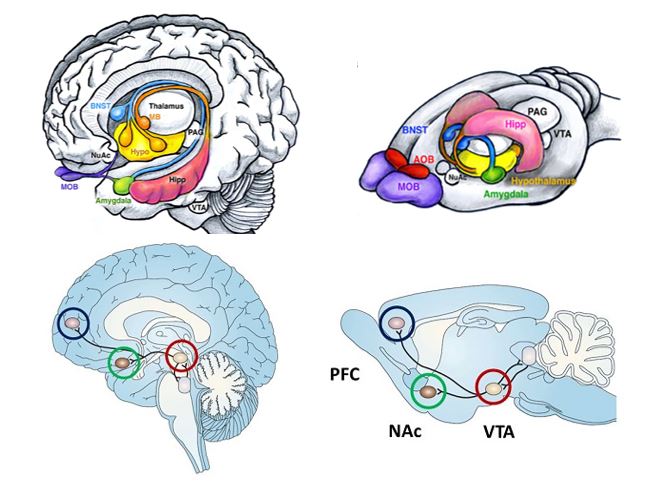Top: Diagram of the human brain and rat brain showing the parts of the limbic system in color. These regions of the brain control innate behaviors and, along with input from the ventral tegemental area nucleus accumbens, and cortex, learned and intentional behaviors. The reward circuit involves the ventral tegmental area, amygdala, nucleus accumbens, and cortex. Abbreviations: BNST, bed nucleus of stria terminalis; Hipp, hippocampus; Hypo, hypothalamus; MB, mamillary bodies; PAG, periaqueductal gray; NuAc, nucleus accumbens; VTA, ventral tegmental area; MOB, main olfactory bulbs; AOB, accessory olfactory bulbs (rat only).
Bottom: Diagram of the reward circuit in human and rat brains. PFC, prefrontal cortex, NAc, nucleus accumbens, VTA, ventral tegmental area. Note that the scales are different for the human and rat brain diagrams. The rat brain is shown enlarged relative to the human brain.
Top image credit: K. Sokolowski, J. G. Corbin, Wired for behaviors: from development to function of innate limbic system circuitry. Front. Mol. Neurosci. (26 April 2012) DOI: 10.3389/fnmol.2012.00055
Bottom image credit: C. G. York, https://slideplayer.com/slide/8133609/
Read more: N. R. Gough, Neuron and Glia Remodeling Contribute to Male Behavior. BioSerendipity (2 March 2019)
https://www.bioserendipity.com/neuron-and-glia-remodeling-contribute-to-male-behavior/.
N. R. Gough, Discovering fast-acting treatments for depression. BioSerendipity (11 January 2019) https://www.bioserendipity.com/discovering-fast-acting-treatments-for-depression/.
N. R. Gough, Giving Mice Artificial Memories to Discover Clues to Depression. BioSerendipity (3 December 2018) https://www.bioserendipity.com/clues-to-depression/.

